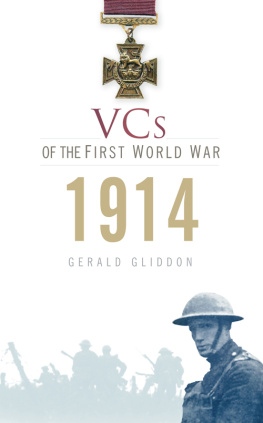Gerald Gliddon - Arras and Messines 1917: VCs of the First World War
Here you can read online Gerald Gliddon - Arras and Messines 1917: VCs of the First World War full text of the book (entire story) in english for free. Download pdf and epub, get meaning, cover and reviews about this ebook. year: 2012, publisher: The History Press, genre: Non-fiction. Description of the work, (preface) as well as reviews are available. Best literature library LitArk.com created for fans of good reading and offers a wide selection of genres:
Romance novel
Science fiction
Adventure
Detective
Science
History
Home and family
Prose
Art
Politics
Computer
Non-fiction
Religion
Business
Children
Humor
Choose a favorite category and find really read worthwhile books. Enjoy immersion in the world of imagination, feel the emotions of the characters or learn something new for yourself, make an fascinating discovery.
- Book:Arras and Messines 1917: VCs of the First World War
- Author:
- Publisher:The History Press
- Genre:
- Year:2012
- Rating:5 / 5
- Favourites:Add to favourites
- Your mark:
- 100
- 1
- 2
- 3
- 4
- 5
Arras and Messines 1917: VCs of the First World War: summary, description and annotation
We offer to read an annotation, description, summary or preface (depends on what the author of the book "Arras and Messines 1917: VCs of the First World War" wrote himself). If you haven't found the necessary information about the book — write in the comments, we will try to find it.
Arras and Messines 1917: VCs of the First World War — read online for free the complete book (whole text) full work
Below is the text of the book, divided by pages. System saving the place of the last page read, allows you to conveniently read the book "Arras and Messines 1917: VCs of the First World War" online for free, without having to search again every time where you left off. Put a bookmark, and you can go to the page where you finished reading at any time.
Font size:
Interval:
Bookmark:
I would like to thank the staff of the following institutions for their assistance during the six-month research for this book: the Commonwealth War Graves Commission, the Imperial War Museum, the National Army Museum and the National Archives. In addition, I would also like to thank the archivists and curators of the many regimental museums and libraries who have responded to my requests for information.
Where recently taken photographs have been included, their owners have been acknowledged with each individual illustration.
As was the case with my earlier books in the VCs of the First World War series, Donald C. Jennings of Florida has been immensely kind in supplying me with pictures of many of the graves or memorials included in this book.
Many of the maps used in this book are from the British military history, Military Operations France and Belgium, 19141918, edited by J.E. Edmonds and published by Macmillan/HMSO from 1922 to 1949.
Maurice Johnson has once again spent many hours in the National Archives in Kew on my behalf, checking the War Diaries of the units involved with the men who won the VC in the first half of 1917. Other individuals who have also given help in many ways include Peter Batchelor, who also compiled the index, Brian Best, John Cameron, Jack Cavanagh, Colonel Terry Cave CBE, Karen Dennis, Bill Fulton, Peter Harris, Steve Snelling, Anthony Staunton and Iain Stewart. Other people who provided either material or assistance but whose names are not mentioned here have been acknowledged in the Sources section at the end of the book.
The History Press has decided to re-issue the VCs of the First World War series in new editions and I have taken advantage of this decision by revising and updating the texts of the current volume.
Since the initial research for this book was carried out nearly fifteen years ago there has been an increasing interest in and awareness of the stories and lives of the men who were awarded the nations and the Commonwealths highest military honour. Evidence of this can be found in the amount of new books being published on the subject, as well as the re-issuing of servicemens records by the National Archives and the accessibility of other records of family history, which are now available via Ancestry, the family history magazine. The internet has also played a major part, although information received using this method should always be verified by cross-checking. Finally, the founding of the Victoria Cross Society in 2002 by Brian Best has encouraged further research and publication of informative articles on the holders of the Victoria Cross.
One of the heartening consequences of this new interest in the subject is in the erection of new or replacement headstones on some of the graves of these brave men, and it is hoped that in time every man who has a grave will have it properly marked.
Gerald Gliddon
Brooke, Norfolk
September 2011
At the Allied Conference at Chantilly in November 1916 it was agreed by the British and French delegations that a joint Allied offensive would be carried out in the New Year, beginning on or about 1 February 1917. However, in December certain political changes took place which affected this agreement. First, David Lloyd George replaced Herbert Asquith as British prime minister, and in France General Joffre was replaced by General Nivelle as Commander-in-Chief of the French Northern Armies. The latter had become a new French hero owing to his recent success at Verdun.
While it was always the intention of Field Marshal Haig, who was Commander-in-Chief of the British Expeditionary Force, to conduct a campaign in Flanders, General Nivelle, seemingly brimming with confidence, had other ideas. He wanted the British to take over another 20 miles of front and to relegate them to carrying out a secondary role containing the German Army. While this was happening, Nivelles army would deliver a knock-out blow against the German Army on the Aisne with the use of twenty-seven divisions.
In Germany the politicians were in favour of negotiating a peace, while Marshal Hindenburg and General Ludendorff wished to bring the Allies to their knees. The German Army had also decided to change their tactics and planned a new line of defence in depth, divided up into a series of zones which they would invite their opponents to attack, thus luring them into a trap that would be difficult to escape from. This line was known to the Germans as the Siegfrid Stelung.
Work on the new line had been progressing for several months and on 4 February 1917 orders were given to the German troops to begin to retreat to this new defence line. Five days later a scorched earth policy was introduced in order to hinder the Allies, who naturally pursued the enemy to their new positions. The Germans took considerable care in destroying road and rail systems, burning and destroying buildings, cutting down trees and poisoning water supplies. In addition, hundreds of mines and booby traps were put in place to hinder the Allied advance. Even dead bodies were wired up with deadly devices for any person who tried to move or bury a corpse. As a result of its retreat to this new line, the German Army reduced its front line by 25 miles and released fourteen extra divisions. Possibly, and of most importance, the new tactic upset the Allies own plans and caused confusion to the High Command.
While General Nivelle was planning his breakthrough on the Aisne, the British and Canadians were to move eastwards from Arras in early April and capture Hill 145, better known as Vimy Ridge. The Third Army under General Allenby was to attack the German lines to the east of Arras, which would involve penetrating part of the newly constructed Hindenburg Line. General Sir Henry Hornes First Army, which included the Canadian Corps, was to take Vimy Ridge and forty-eight tanks as well as 2,800 guns were to be used in the attack. To the south, the German vacation of the Bapaume Salient led to problems for the British artillery, which now had to move across an area devastated by the departing German Army.
The battle of Arras was delayed by one day and began on 9 April Easter Monday. Weather conditions could not have been worse and included snow, sleet and sheer cold. Despite this, the initial progress of the Allied Army was successful. In the centre of the battlefield the 12th and 15th Divisions managed to advance up to 2 miles. To the left the Canadian Corps had secured Vimy Ridge, their main objective, and they now had observation over the German-held plain of Douai. It was a magnificent achievement and one which has been written about in countless books. To the right of the line the fortified village of Neuville-Vitasse also fell to the Allies.
At Bullecourt, though, things had gone desperately wrong and General Goughs late decision to use tanks to break down the German wire, without adequate preparation or rehearsal, turned out to be a major blunder. One feels that after Bullecourt, which was basically an Australian affair, General Gough would not be trusted again. Men had been needlessly sacrificed owing to sheer incompetence.
On 11 April, two days after the attack began, the British managed to capture the strategically important hill village of Monchy-le-Preux, a major achievement. Nevertheless, the German Army was recovering, and gaps were being plugged and reinforcements brought up. Using hindsight, it might well have been sensible to have stopped the advance there and then. However, Haig was committed to supporting the Nivelle Offensive and really had little choice; the attack had to continue. Unfortunately, the Nivelle Offensive on the Aisne turned out to be a disaster, caused largely by the French generals over-optimism. He promised to deliver a victory and he did not succeed. French casualties numbered 187,000 compared to a German total of 163,000. As a result of this defeat Nivelle was replaced by General Ptain, and General Foch was appointed Chief of General Staff.
Font size:
Interval:
Bookmark:
Similar books «Arras and Messines 1917: VCs of the First World War»
Look at similar books to Arras and Messines 1917: VCs of the First World War. We have selected literature similar in name and meaning in the hope of providing readers with more options to find new, interesting, not yet read works.
Discussion, reviews of the book Arras and Messines 1917: VCs of the First World War and just readers' own opinions. Leave your comments, write what you think about the work, its meaning or the main characters. Specify what exactly you liked and what you didn't like, and why you think so.













